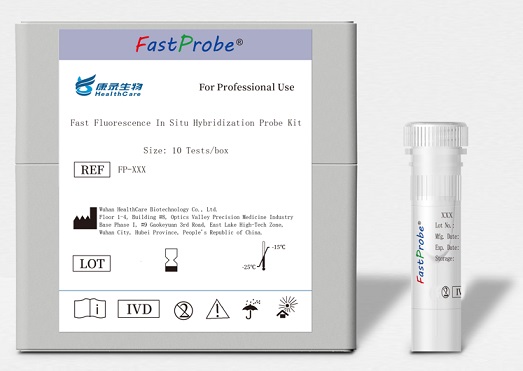IVD - FP328 CCND2/IGH Gene Fusion Probe Detection Kit

Cat.# FP-328: CCND2/IGH Gene Fusion Probe Detection Kit
[Overview]
The protein encoded by CCND2 gene belongs to the highly conserved cyclin family, whose members are characterized by a dramatic periodicity in protein abundance through the cell cycle. Cyclins function as regulators of CDK kinases. Different cyclins exhibit distinct expression and degradation patterns which contribute to the temporal coordination of each mitotic event. This cyclin forms a complex with CDK4 or CDK6 and functions as a regulatory subunit of the complex, whose activity is required for cell cycle G1/S transition. This protein has been shown to interact with and be involved in the phosphorylation of tumor suppressor protein Rb. Knockout studies of the homologous gene in mouse suggest the essential roles of this gene in ovarian granulosa and germ cell proliferation. High level expression of this gene was observed in ovarian and testicular tumors. Mutations in this gene are associated with megalencephaly-polymicrogyria-polydactyly-hydrocephalus syndrome 3 (MPPH3). [provided by RefSeq, Sep 2014].
Immunoglobulins recognize foreign antigens and initiate immune responses such as phagocytosis and the complement system. Each immunoglobulin molecule consists of two identical heavy chains and two identical light chains. This region represents the germline organization of the heavy chain locus. The locus includes V (variable), D (diversity), J (joining), and C (constant) segments. During B cell development, a recombination event at the DNA level joins a single D segment with a J segment; this partially rearranged D-J gene is then joined to a V segment. The rearranged V-D-J is then transcribed with the IGHM constant region; this transcript encodes a mu heavy chain. Later in development B cells generate V-D-J-Cmu-Cdelta pre-messenger RNA, which is alternatively spliced to encode either a mu or a delta heavy chain. Mature B cells in the lymph nodes undergo switch recombination, so that the V-D-J gene is brought in proximity to one of the IGHG, IGHA, or IGHE genes and each cell expresses either the gamma, alpha, or epsilon heavy chain. Recombination of many different V segments with several J segments provides a wide range of antigen recognition. Additional diversity is attained by junctional diversity, resulting from the random addition of nucleotides by terminal deoxynucleotidyltransferase, and by somatic hypermutation, which occurs during B cell maturation in the spleen and lymph nodes. Due to polymorphism, the numbers of functional V, J, and D genes differ among individuals and some V, D, J, and C segments may be pseudogenes. [provided by RefSeq, Dec 2017].
[Download] CCND2/IGH Gene Fusion Probe Instructions
[Download MSDS] MSDS

